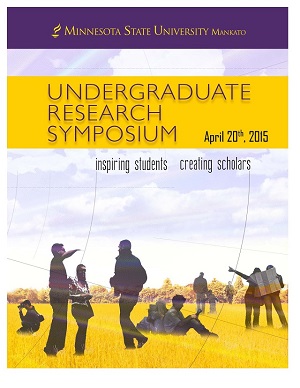Locating the Muscle Protein FER-1: A Protein in Muscle Repair with Implications for Muscular Dystrophy
Location
CSU 255
Start Date
20-4-2015 11:05 AM
End Date
20-4-2015 12:05 PM
Student's Major
Biological Sciences
Student's College
Science, Engineering and Technology
Mentor's Name
Kelly Grussendorf
Mentor's Email Address
kelly.grussendorf@mnsu.edu
Mentor's Department
Biological Sciences
Mentor's College
Science, Engineering and Technology
Description
Limb Girdle Muscular Dystrophy (LGMD) is a genetic disease characterized by the degradation of muscle tissue. Research suggests a mutated cellular protein called dysferlin is implicated in the mechanism responsible for the inadequate muscle repair that occurs in people with LGMD. Dysferlin belongs to a large family of proteins called Ferlins. These proteins have been discovered to exhibit similar function across species, which allows for the comparison studies within different organisms. The FER-1 protein in C. elegans is the homologous protein to dysferlin in humans. Early evidence suggests fer-1 may be expressed in the body wall muscle. As this could prove to be a powerful tool for the study of LGMD, is it therefore important to determine if and where fer-1 is being expressed and in which type of muscles. The larger scope of this study is to identify the expression location of fer-1 in C. elegans. To start, recombinant DNA technology was used to isolate genomic DNA from C. elegans. This genomic DNA is known to contain the fer-1 gene. Following this, bacteria plasmid DNA was also isolated from E. coli. The plasmid DNA contains a DNA marking tool allowing for protein expression to be visualized. Both sets of DNA were isolated successfully and validated by gel electrophoresis. By isolating these DNA, they can be recombined to use as a probe for viewing the location of fer-1 expression using fluorescence microscopy.
Locating the Muscle Protein FER-1: A Protein in Muscle Repair with Implications for Muscular Dystrophy
CSU 255
Limb Girdle Muscular Dystrophy (LGMD) is a genetic disease characterized by the degradation of muscle tissue. Research suggests a mutated cellular protein called dysferlin is implicated in the mechanism responsible for the inadequate muscle repair that occurs in people with LGMD. Dysferlin belongs to a large family of proteins called Ferlins. These proteins have been discovered to exhibit similar function across species, which allows for the comparison studies within different organisms. The FER-1 protein in C. elegans is the homologous protein to dysferlin in humans. Early evidence suggests fer-1 may be expressed in the body wall muscle. As this could prove to be a powerful tool for the study of LGMD, is it therefore important to determine if and where fer-1 is being expressed and in which type of muscles. The larger scope of this study is to identify the expression location of fer-1 in C. elegans. To start, recombinant DNA technology was used to isolate genomic DNA from C. elegans. This genomic DNA is known to contain the fer-1 gene. Following this, bacteria plasmid DNA was also isolated from E. coli. The plasmid DNA contains a DNA marking tool allowing for protein expression to be visualized. Both sets of DNA were isolated successfully and validated by gel electrophoresis. By isolating these DNA, they can be recombined to use as a probe for viewing the location of fer-1 expression using fluorescence microscopy.
Recommended Citation
Morehead, Michael. "Locating the Muscle Protein FER-1: A Protein in Muscle Repair with Implications for Muscular Dystrophy." Undergraduate Research Symposium, Mankato, MN, April 20, 2015.
https://cornerstone.lib.mnsu.edu/urs/2015/oral_session_06/1



